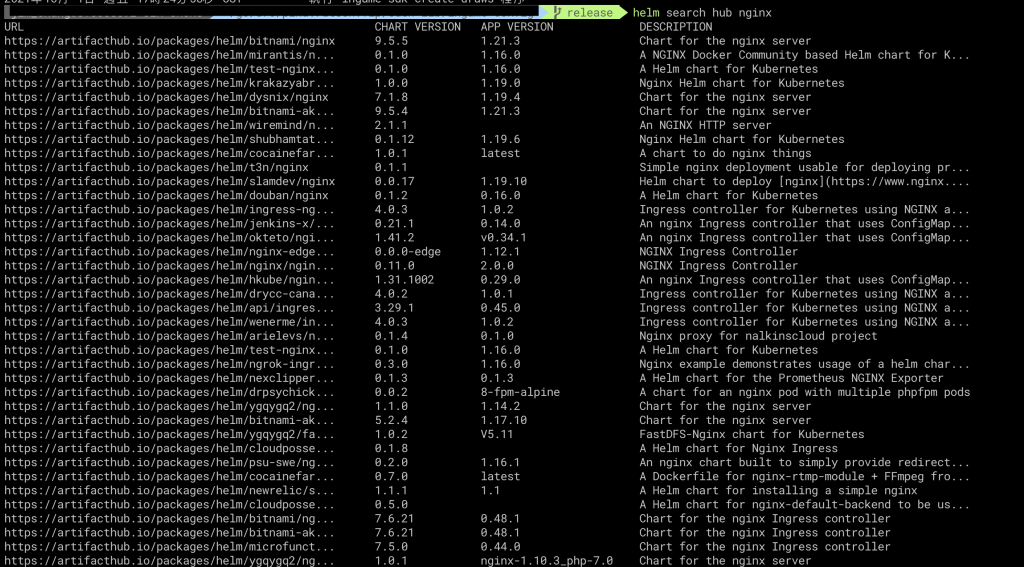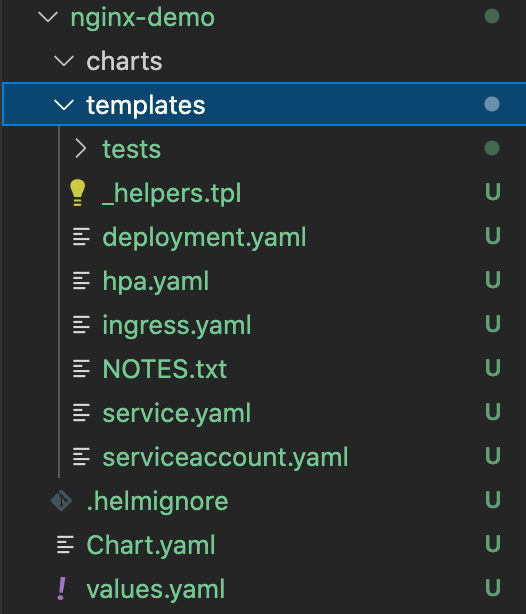Day24-DIY总是比较麻烦 如何建立chart
在上一章我们使用的仓库内的chart,这章後面会介绍怎麽建立自己的chart,不过在建立自己的的chart前,可以看看是否已经有线上写好的版本,这时你就需要透过指令寻找chart。
search chart
当你想要寻找特定chart时,可以透过search指令来寻找chart,
helm search hub
或者
helm search repo
这两者的差别在於 search hub 是去Artifact hub 找寻chart。
如下图:

而helm search repo则是搜寻你加到本机repo的chart(用helm repo add)加到本机的。
如下图:

可以看到从线上的Artifact hub找到的chart比我们当初加入到本地repo的chart多上很多,如果只是单纯要找chart的话,可以用search hub去寻找即可。
如果你看了线上的chart都没有你要的,就可以建立一个自己的chart。
建立chart
要建立自己的chart,可以透过helm create指令:
helm create nginx-demo
他会建出像下图的目录:

打开deployment.yaml,可以看到他出现下面这种格式:
apiVersion: apps/v1
kind: Deployment
metadata:
name: {{ include "nginx-demo.fullname" . }}
labels:
{{- include "nginx-demo.labels" . | nindent 4 }}
spec:
{{- if not .Values.autoscaling.enabled }}
replicas: {{ .Values.replicaCount }}
{{- end }}
selector:
matchLabels:
{{- include "nginx-demo.selectorLabels" . | nindent 6 }}
template:
metadata:
{{- with .Values.podAnnotations }}
annotations:
{{- toYaml . | nindent 8 }}
{{- end }}
labels:
{{- include "nginx-demo.selectorLabels" . | nindent 8 }}
spec:
{{- with .Values.imagePullSecrets }}
imagePullSecrets:
{{- toYaml . | nindent 8 }}
{{- end }}
serviceAccountName: {{ include "nginx-demo.serviceAccountName" . }}
securityContext:
{{- toYaml .Values.podSecurityContext | nindent 8 }}
containers:
- name: {{ .Chart.Name }}
securityContext:
{{- toYaml .Values.securityContext | nindent 12 }}
image: "{{ .Values.image.repository }}:{{ .Values.image.tag | default .Chart.AppVersion }}"
imagePullPolicy: {{ .Values.image.pullPolicy }}
ports:
- name: http
containerPort: 80
protocol: TCP
livenessProbe:
httpGet:
path: /
port: http
readinessProbe:
httpGet:
path: /
port: http
resources:
{{- toYaml .Values.resources | nindent 12 }}
{{- with .Values.nodeSelector }}
nodeSelector:
{{- toYaml . | nindent 8 }}
{{- end }}
{{- with .Values.affinity }}
affinity:
{{- toYaml . | nindent 8 }}
{{- end }}
{{- with .Values.tolerations }}
tolerations:
{{- toYaml . | nindent 8 }}
{{- end }}
上图当中可看到不少.Values.replicaCount这种格式的设定,这时打开values.yaml
直接搜寻replicaCount,可以找到这个
replicaCount: 1
这边代表当你使用helm install或helm update时,就会使用values.yaml内设定的数值。不过,如果要让不同站别使用不同设定,还需要别的处理方式,这部分会留到下一章讲解。
【day5】二林&员林特色小吃
疫情前期看到千千拍摄《我们回家吧》系列 刚好跟男友回员林 所以就照着千千的推荐名单走一次罗 阳光老店...
第51天~
这个得上一篇:https://ithelp.ithome.com.tw/articles/10259...
椭圆曲线数字签名算法 (Elliptic Curve Digital Signature Algorithm:ECDSA)
椭圆曲线数字签名算法 (ECDSA) 是FIPS 186-4批准的合法数字签名算法。这意味着 ECD...
Vuex 是什麽
Vuex 是 Vue 提供的一种资料状态管理的模式,它可以统一控管资料的状态,都是在小型的 SPA ...
Day12-Webhook 实作(一)LINEBot Channel 申请、SDK 安装
大家好~ 接下来就用 LINEBot 当我们 Webhook 的实作练习吧! Channel 申请 ...